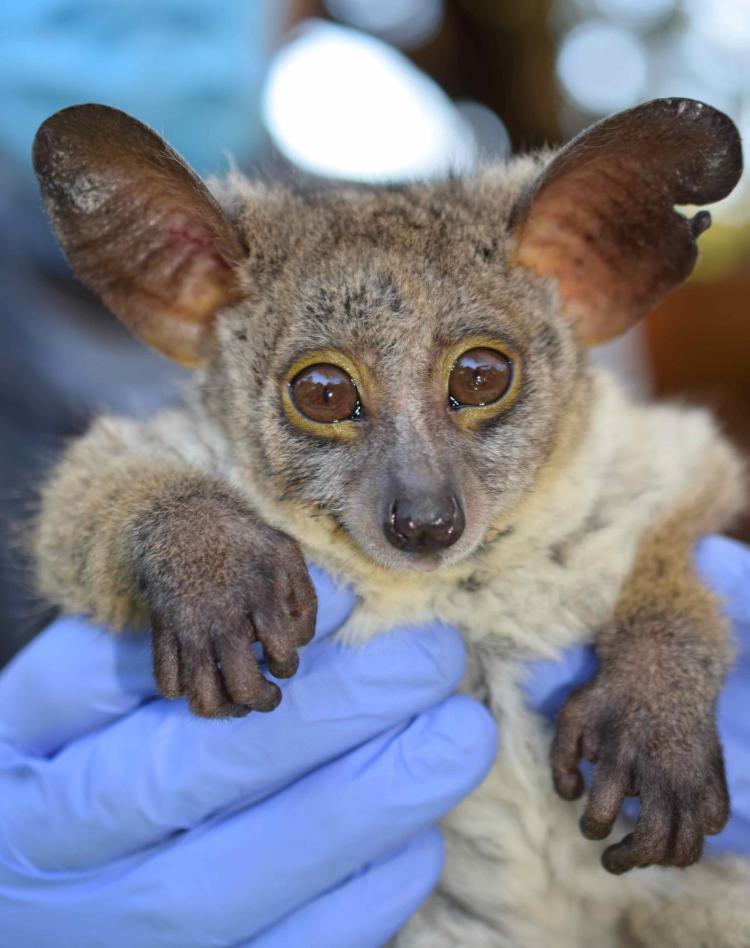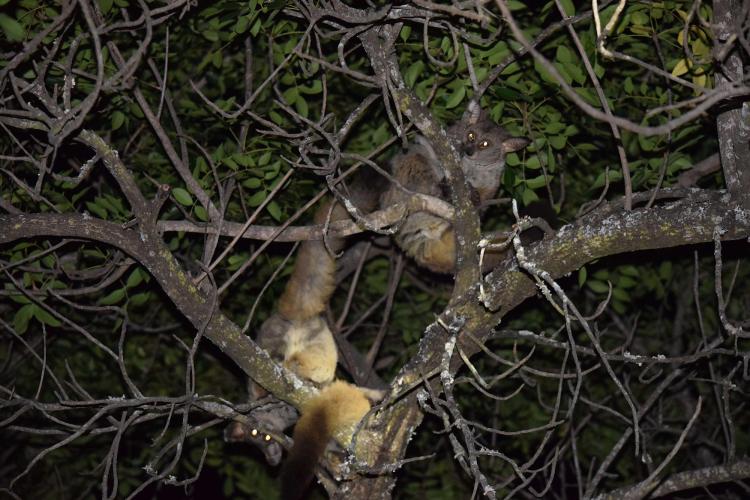Female bushbabies more stressed, may be more vulnerable to changing environment
Banner image: A thick-tailed greater galago, or bushbaby, hides out in a tree at night. (Credit: Michelle Sauther)
A new study has explored the yearly routine of a small primate called the thick-tailed greater galago (Otolemur crassicaudatus), discovering that females may be under a lot more stress than males.
The findings raise possible alarm bells for the conservation of greater galagos, sometimes called bushbabies, which are native to sub-Saharan Africa, and other primate populations across the globe—especially ones in which females carry the sole burden of raising offspring. The researchers, including anthropologist Michelle Sauther of CU Boulder, published their results Oct. 25 in the journal Conservation Physiology.
“There’s been a trend of decreasing primate populations around the world over the last few years,” said Channen Long, lead author of the new study and a doctoral student at the University of Pretoria in South Africa. “We’re trying to see if there are any driving forces that could be affecting these galagos now or might affect them in the future.”
The team’s new study takes a journey to the Lajuma Research Centre, sitting at an altitude of 1,200 meters (4,000 feet) and higher, in the Soutpansberg mountains of northern South Africa. Here, you’ll find five primate species, including greater galagos. They grow to about the size of a small housecat and have bushy tails.
The International Union for Conservation of Nature (IUCN) currently lists the cute primate’s status as “least concern.” But bushbabies face a number of threats from humans, and have been killed by cars, power lines and dogs. In recent years, temperatures in the mountain range have also soared, while humans have leveled forests to make room for macadamia farms and other agriculture, Long said.
To get a better idea of what may lie in store for the bushbabies, the researchers collected 186 fecal samples from wild bushbabies at Lajuma. They then tested those samples for the byproducts of glucocorticoids, a class of hormones that mammals produce when they’re coping with stressful conditions. The team discovered that female bushbabies seem to experience sharper increases in the hormones than males. That usually happens in the Southern Hemisphere springtime, or around October and November, when females give birth and nurse their young.
Those patterns, Sauther said, could hint that female bushbabies will have less wiggle room to work with as they try to survive in a changing environment.
“One thing that always surprises me is how resilient wild animals can be,” said Sauther, professor in the Department of Anthropology at CU Boulder. “They have a lot thrown at them in their environments, and they deal with it quite well. But everybody reaches their limit.”
A bruising life
Sauther has spent years traveling to Lajuma to study the primates there. Winters can get chilly in the Soutpansberg mountains, she said, dipping down to lows of about 0 degrees Celsius (32 degrees Fahrenheit).
During her time in those forests, one particular bushbaby stood out for the anthropologist. He was a male who was missing an eye and always seemed to be getting in fights with other males over females. Sauther and study coauthor Frank Cuozzo, a CU Boulder alumnus, nicknamed the primate Bruiser.
“These galagos are quirky,” Sauther said. “They have a lot of interesting personalities.”
Such a hard-knock life, however, can take a toll on an animal’s body. Study coauthor Juan Scheun explained that when mammals experience stress—they get beat up, say, or can’t find enough food—their bodies will produce a pulse of glucocorticoids.
“It helps animals to get more energy,” said Scheun, a postdoctoral fellow at the University of South Africa. “It gives you that extra oomph you need to survive.”
Too much of that oomph, however, can backfire. When animals experience stress for too long, the constant exposure to high levels of glucocorticoids may weaken their immune systems and even affect their brain functioning.
In the new study, the researchers set out to discover just how well Bruiser and his friends and enemies were handling stress in the forests of Lajuma.
Sex differences
The team spent a year hiking through Lajuma, tracking the animals as they foraged for insects, fruits and tree gum in the summers and faced leaner times in the winter. They collected monthly fecal samples from individual bushbaies during that time. Long explained that poop samples contain a record of the byproducts, or metabolites, of glucocorticoid hormones.
She added that the team assumed that those hormone levels would jump up in males during the mating season from June to August when they tussled over females.
“I was expecting to see some sort of elevation within that winter period during the mating season, but we didn’t see anything,” Long said.
Scheun noted that the team’s findings may indicate that female and male bushbabies face different pressures in their environments—a finding that he thinks could prove true in some other primate species. When it comes to protecting at-risk species, in other words, the sexes may not always be equal.
“In most mammals, females carry the brunt of the work, especially around raising young,” Scheun said. “For a lot of primate species, I think you’re going to need to look at sex differences when making conservation decisions.”
Other coauthors of the new study include CU Boulder alumnus James Millette and Adrian Tordiffe and Andre Ganswindt of the University of Pretoria.




